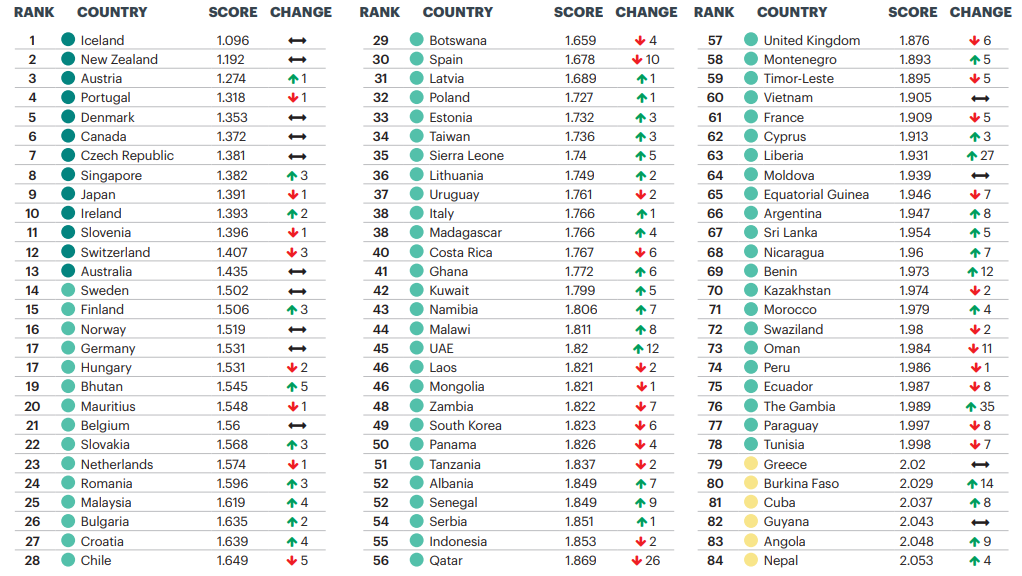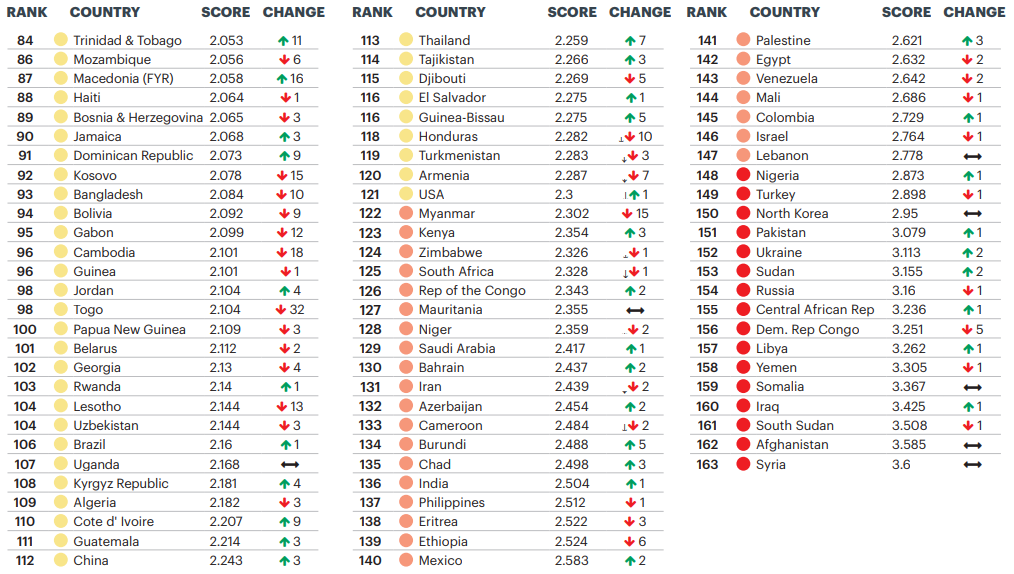Summary:
- The 12th edition of the annual Global Peace Index (GPI) report highlights 92 countries deteriorated whilst 71 countries improved between 2016 and 2017 - the worst result in the last four years;
- Over the last decade, the GDP growth of countries that improved in peace was seven times higher than that of countries that deteriorated in peace and military expenditure as a portion of GDP has been falling in more countries than increasing;
- The economic impact of violence was USD14.8 trillion in 2017, according to the study or 12.4% of global GDP - this is equivalent to nearly USD2,000 per person;
- For the first time in modern history, refugees made up almost 1 per cent of the global population in 2017 - greater than the population of the UK or nearly half the population of Russia.
The largest contributors to the deterioration in the last year were the escalations in both interstate and internal armed conflicts, rise in political terror and reduced commitment to UN peacekeeping. Syria, Afghanistan, South Sudan, Iraq and Somalia are the least peaceful countries whilst Iceland, New Zealand, Austria, Portugal and Denmark are the most peaceful countries.
The GPI is recognised among the world's leading measure of global peacefulness. The report covers 99.7% of the world's population and uses 23 qualitative and quantitative indicators from highly respected sources to compile the index. These indicators are grouped into three key domains: 'ongoing conflict', 'safety and security', and 'militarisation'. All three domains deteriorated over the last year.
Despite retaining its position as the most peaceful region in the world, Europe deteriorated for the third successive year. For the first time in the history of the index, a Western European country experienced one of the five largest deteriorations with Spain falling ten places in the rankings to 30th, owing to internal political tensions and an increase in the impact of terrorism. In the last decade, 61% of the countries in Europe deteriorated, due to higher levels of political instability, increased impact from terrorism, and increased perceptions of criminality. No single Nordic country is more peaceful now than in 2008.
Surprisingly, the indicator with the largest improvement last year was military expenditure as a portion of GDP, with 88 countries spending less and 44 spending more. Average country military expenditure as a percentage of GDP has continued its decade long decline, with 102 countries spending less. Three of the five Scandinavian countries are amongst the largest weapons exporters when measured as a percentage of GDP.
The economic impact of violence on the global economy in 2017 was USD14.8 trillion in purchasing power parity (PPP) terms. This figure is equivalent to 12.4% of the world's economic activity (gross world product), or USD1,988 for every person. The economic impact of violence increased by 2% during 2017 due to increases in the cost of conflict and internal security expenditures, with the largest increases being in security spending occurring in China, Russia and South Africa.
This year's report also finds that highly peaceful countries also have considerable economic advantages over the least peaceful countries: inflation rates are nearly three times higher in low peace economies, interest rates were found to be over twice as high and foreign direct investment was nearly half.
The US score continued to decline, driven by increased political instability, despite reductions in the impact from terrorism and militarisation. The US is now one of the seven G20 members amongst the 50 least peaceful countries in the world, along with Mexico, South Africa, Saudi Arabia, India, Turkey and Russia.
Six of the nine regions of the world deteriorated in peacefulness with the four most peaceful regions, Europe, North America, Asia-Pacific and South America, all deteriorating too. Here's the regional perspective as highlighted by the GPI.
- The Middle East and North Africa remained the world's least peaceful region in 2018, despite a slight improvement in its score - the result of improvements in Iraq and Syria due to the diminishing reach of ISIL. Qatar experienced the single largest deterioration in peacefulness, as the political and economic boycott placed on it by the UAE, Saudi Arabia, Egypt, and Bahrain led to deteriorations in relations with neighbouring countries, and political instability.
- The broad trend in Europe has been a convergence in peace with the most peaceful, predominately those in Western Europe, declining in peacefulness, while those with weaker scores, many of them in Eastern Europe, improving.
- The Asia-Pacific region's peacefulness deteriorated, with 11 countries falling while eight improved. Myanmar had the biggest deterioration, falling 15 places. Australia had the second largest deterioration due to higher levels of incarceration and higher levels of militarisation.
- In North America, the level of peacefulness in the United States has declined for the second consecutive year and is now at the worst level of any time since 2012. Canada suffered a deterioration in its terrorism impact rating after the Quebec City and Edmonton attacks.
- Russia and Eurasia remained in seventh place despite a slight deterioration in the overall score. The Ukraine, the Kyrgyz Republic and Moldova improved their scores while nine other countries deteriorated. Russia had the second largest deterioration after Armenia.
- The biggest challenge to peace in Central America and the Caribbean is crime and corruption. For the last eight years, the region has had the worst scores in the index for homicide rate, violent crime, and perceptions of criminality.
- South America continues its struggle with lawlessness. The most significant riser in the region was Argentina, followed by Brazil and Colombia.
- The inequality of peace in South Asia continued to widen over the year, with the least peaceful nations - Afghanistan and Pakistan - continuing their decline, while the most peaceful - Bhutan and Sri Lanka - continued to improve.
- Sub-Saharan Africa was home to four of the five largest improvements in peacefulness, the Gambia, Liberia, Burundi, Senegal. Peacefulness in the Democratic Republic of the Congo continued to deteriorate, affecting the country's prospects for weathering crises like the ongoing Ebola epidemic.
READ MORE: The GPI report, videos, and interactive maps are available at: Vision of Humanity

